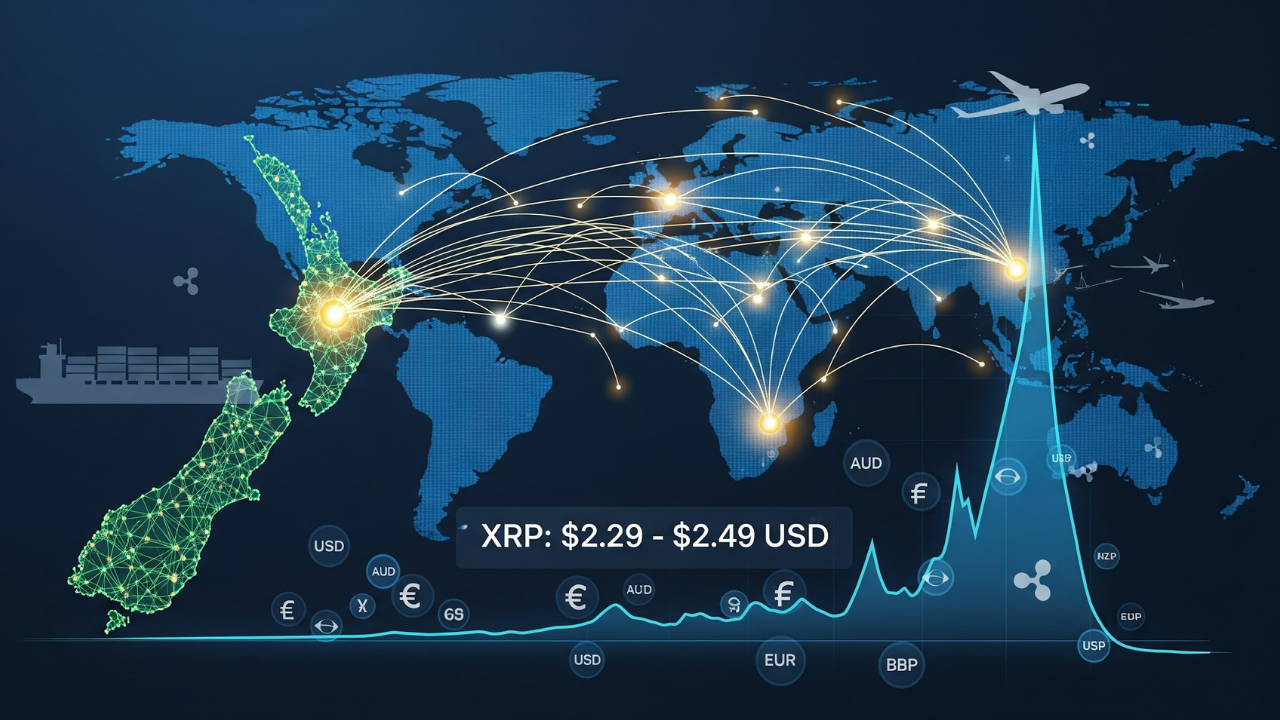International payment networks rely on sophisticated liquidity management systems that enable seamless currency conversions and instant settlements across borders. Market makers and financial institutions maintain reserves of multiple currencies to facilitate real-time transactions, but understanding factors such as ripple price movements, settlement speeds, and spread costs becomes essential for businesses optimizing their international payment strategies.
The current trading value of XRP stands at approximately $2.29-$2.49 USD, positioning Ripple’s native token as a viable bridge currency for cross-border liquidity provision. New Zealand businesses engaged in international trade particularly benefit from understanding how liquidity mechanisms affect transaction costs and settlement efficiency when dealing with Australian and global trading partners.
Market Maker Functions in Foreign Exchange Operations
Market makers serve as crucial intermediaries that maintain continuous buy and sell orders for currency pairs, ensuring participants can execute transactions at any time without significant delays. These entities provide price continuity by keeping asset prices consistent and reducing sudden fluctuations that could disrupt business operations. The difference between bid and ask prices represents the spread, which reflects the cost of trading and serves as the market maker’s profit margin for facilitating transactions. Market makers populate order books with orders at various price levels, creating depth that allows large transactions to be executed with minimal price impact.
By continuously offering to buy at slightly lower prices and sell at slightly higher prices, market makers absorb supply and demand imbalances that would otherwise create excessive volatility. This stabilization function proves particularly valuable for businesses managing frequent or large international transactions, as tighter spreads reduce overall currency exchange costs.
Traditional Banking Infrastructure for Cross-Border Payments
Conventional international payment systems rely on correspondent banking relationships involving multiple intermediaries across different time zones and regulatory frameworks. These arrangements have been the standard for decades, but incur high fees and slow settlement times that disrupt cash flow and increase operational costs for businesses and individuals. New Zealand banks charge substantial fees for international transfers, with outgoing payments costing between $5-$25, depending on service method, and incoming transfers adding $10-$15 per transaction.
Additional costs arise from correspondent bank fees, intermediary bank charges, and exchange rate markups that banks apply above mid-market rates. Traditional international money transfers typically require three to five days to settle, during which funds remain inaccessible, and businesses face exchange rate risk exposure. The capital locked in nostro and vostro accounts across multiple jurisdictions represents another hidden cost, as financial institutions must maintain pre-funded reserves in foreign currencies to facilitate customer transactions.
Ripple’s On-Demand Liquidity Solution for Settlement Efficiency
On-Demand Liquidity leverages XRP as a bridge currency that eliminates the need for banks or financial institutions to pre-fund nostro accounts in recipient currencies. This approach converts the sender’s currency into XRP, transfers the digital asset across borders instantly, and converts it back into the receiver’s currency, all within seconds. The XRP Ledger employs a unique consensus mechanism called the Ripple Protocol Consensus Algorithm that differs from traditional Proof-of-Work or Proof-of-Stake systems, enabling transaction validation in approximately three to five seconds.
Financial institutions utilizing RippleNet can settle international payments in mere seconds compared to traditional systems requiring multiple days, providing near-instantaneous finality that enhances customer experience and competitive positioning. By freeing capital that would otherwise be locked in nostro-vostro arrangements, businesses can deploy resources more strategically and improve liquidity management without maintaining idle capital reserves across multiple currencies.
Analyzing Spread Costs for Australian Trading Partners
The NZD to AUD exchange rate currently trades at approximately 0.876-0.882, reflecting the close economic relationship between Australia and New Zealand. Traditional foreign exchange transactions involve bid-ask spreads that represent the market maker’s compensation for providing liquidity and managing inventory risk. When New Zealand businesses convert currencies through conventional banking channels, exchange rate markups above mid-market rates add hidden costs that may not be immediately apparent in advertised fee structures. Correspondent banking fees and intermediary charges further erode the value of international transfers, with some banks charging flat fees while others apply percentage-based deductions.
Market makers quote competitive bid-ask spreads to reduce trading costs for participants, which proves especially valuable for companies managing frequent transactions with Australian suppliers or customers. Cryptocurrency-based payment rails offer alternatives that dramatically reduce these costs, with platforms bypassing multiple intermediaries and enabling direct peer-to-peer value transfer.
Currency Conversion Risk Management Strategies
Exchange rate fluctuations create significant exposure for businesses engaged in international commerce, as currency values respond to economic conditions, interest rates, and geopolitical events. Foreign exchange rates impact export competitiveness by affecting how expensive domestic goods appear to foreign buyers, with stronger currencies potentially reducing export volumes while weaker currencies make products more attractive internationally. Risk management approaches include hedging strategies that lock in exchange rates for future transactions, protecting companies from adverse currency movements that could affect costs or revenues.
The forex market’s high liquidity ensures businesses can quickly convert currencies without significant delays or price slippage, though this advantage diminishes during periods of extreme volatility. Real-time transaction processing through blockchain-based systems reduces exposure windows by enabling instant conversion and settlement, minimizing the time during which exchange rate fluctuations can impact transaction values. Transparency features inherent in distributed ledger technology provide greater visibility into transaction flows, helping businesses make informed decisions about timing and execution strategies.
Cost Comparison Between Traditional and Digital Payment Networks
Traditional cross-border payment systems involve several intermediaries, including acquirers, issuing banks, processors, clearinghouses, and correspondent banks, each extracting fees to cover operations and risk management. Ripple’s technology significantly reduces transaction costs compared to conventional methods by eliminating the need for multiple intermediaries and enabling direct transfers, allowing financial institutions to avoid high fees while enjoying competitive exchange rates.
Transaction costs on the XRP Ledger remain minimal, with network fees typically measuring fractions of a cent per transaction compared to traditional banking charges that can reach $25-$50 for staff-assisted international transfers. The elimination of correspondent banking fees and reduced need for foreign currency reserves result in substantial cost savings that businesses can reinvest in growth or pass along to customers through competitive pricing.
Financial institutions implementing blockchain-based payment infrastructure report improved operational efficiency through automated processes that reduce manual reconciliation requirements and associated labor costs. For New Zealand exporters and importers dealing with Australian partners, these cost reductions translate directly into improved profit margins and enhanced competitiveness in regional markets.
Settlement Speed Advantages for New Zealand Businesses
Traditional international transfers between New Zealand and Australian banks typically settle within one to three business days, though complex transactions involving multiple intermediaries may require longer processing times. This settlement lag creates working capital challenges as businesses cannot access funds during transit periods, potentially disrupting operations requiring immediate payment for goods or services. Prefunded models adopted by fintech providers enable faster payments by maintaining reserves in destination countries, though this approach requires significant capital allocation and limits scalability.
Blockchain-based settlement systems process transactions in real-time, with XRP transfers completing in three to five seconds from initiation to final confirmation on the distributed ledger. Multinational corporations leveraging RippleNet execute complex payments involving multiple currencies and jurisdictions by seamlessly converting funds for rapid settlement, reducing both time and costs while minimizing foreign exchange risks. The velocity improvement from multi-day settlement to near-instantaneous finality fundamentally changes cash flow management capabilities and allows businesses to operate with greater financial agility.
Regional Integration and Asia-Pacific Payment Corridors
The Asia-Pacific region represents a major focus area for remittance platforms and payment providers seeking to optimize cross-border money transfer efficiency. XRP’s design as a high-speed, low-cost settlement token aligns with regional requirements for efficient value transfer across diverse currencies and regulatory environments. Ripple’s partnerships with remittance platforms such as Tranglo and SBI Remit, both operating heavily in Asia-Pacific corridors, directly affect XRP’s utility and demand throughout the region, including Australia and New Zealand. New Zealand businesses trading with Asian counterparts benefit from payment networks that reduce friction in multi-hop transactions involving currency conversions through several intermediaries.
The extensive network of global partners accessible through RippleNet expands institutional reach and facilitates efficient cross-border transactions that would be prohibitively expensive or slow through traditional correspondent banking arrangements. Regional payment infrastructure developments increasingly focus on real-time gross settlement systems that leverage distributed ledger technology to improve speed, reduce costs, and enhance transparency.
Liquidity Management for Financial Institutions
Financial institutions must balance liquidity demands with comprehensive risk management frameworks when providing instant settlement capabilities across multiple jurisdictions and currencies. Liquidity providers continuously assess potential risks in global markets, adjusting reserves as needed to respond to exchange rate fluctuations and maintain stability during volatile periods. The capital efficiency gained through eliminating pre-funded nostro accounts allows banks to redeploy resources toward lending operations or other productive uses rather than maintaining idle balances in foreign currency accounts.
On-Demand Liquidity provides financial institutions with access to real-time liquidity by converting currencies through XRP as a bridge asset, ensuring sufficient reserves for instant conversions at competitive rates without maintaining permanent foreign currency positions. Advanced trading strategies and technology employed by market makers help manage inventory risk while providing consistent bid-ask quotations that enable smooth market functioning. For New Zealand banks serving business clients engaged in Australian trade, improved liquidity management translates into better pricing, faster service, and reduced operational complexity.
Transparency and Compliance Benefits
Blockchain technology underlying modern payment networks provides enhanced transparency through immutable transaction records that all participants can verify. This transparency helps mitigate fraud risk and improve compliance with regulatory requirements by creating auditable trails that authorities can examine without compromising operational security. Real-time visibility into payment flows enables better cash flow management and financial planning, as businesses can track exactly when funds leave one account and arrive in another. Accurate tracking and verification capabilities prove particularly valuable for businesses managing multiple international transactions simultaneously, as automated reconciliation reduces accounting workload and human error. The decentralized network connecting diverse financial institutions worldwide provides a secure infrastructure that distributes risk rather than concentrating it in single points of failure. Enhanced transparency throughout transaction processes builds trust among trading partners and reduces disputes arising from unclear settlement status or unexpected fee deductions.
Liquidity provision remains fundamental to efficient cross-border payment operations, with market makers and financial institutions playing essential roles in maintaining currency exchange functionality. New Zealand businesses engaged in international trade benefit from understanding how spread costs, settlement speeds, and liquidity management approaches affect transaction economics.
While traditional correspondent banking systems continue serving the majority of international transfers, emerging blockchain-based alternatives offer compelling advantages through reduced costs, faster settlement, and improved capital efficiency. The convergence of conventional finance infrastructure with distributed ledger technology creates opportunities for businesses to optimize payment strategies and enhance competitiveness in regional and global markets.








